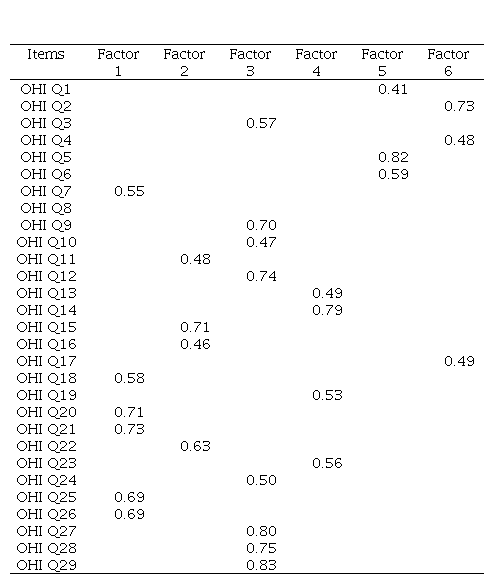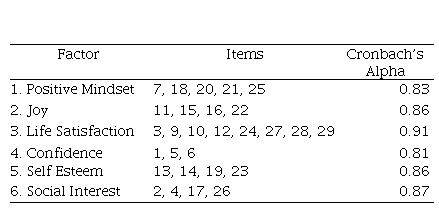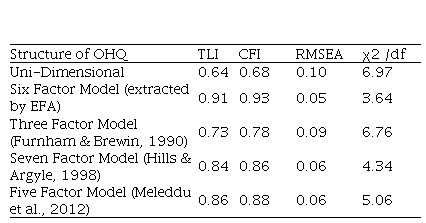Ahuvia, A. C. (2002). Individualism/collectivism and cultures of happiness: A theoretical conjecture on the relationship between consumption, culture and subjective well-being at the national level. Journal of Happiness Studies, 3(1), 23-36. https://doi.org/10.1023/A:1015682121103
Argyle, M. (2001). The psychology of happiness. East Sussex: Routledge.
Argyle, M., Martin, M., & Crossland, J. (1989). Happiness as a Function of Personality and Social Encounters. In J. P. Forgas and J. M. Innes (Ed.), Recent advances in social psychology: An international perspective (pp. 189-203). North-Holland: Elsevier Science Publishers.
Beck, A. T., Ward, C. H., Mendelson, M., Mock, J., & Erbaugh, J. (1961). An inventory for measuring. Archives of General Psychiatry, 4(6), 561-571. https://doi.org/10.1001/archpsyc.1961.01710120031004
Biswas-Diener, R., Tay, L., & Diener, E. (2012). Happiness in India. In H. Selin & G. Davey (Eds.), Happiness across cultures (pp. 13-25). Springer, Dordrecht.https://doi.org/10.1007/978-94-007-2700-7_2
Chamorro-Premuzic, T., Bennett, E., & Furnham, A. (2007). The happy personality: Mediational role of trait emotional intelligence. Personality and Individual Differences, 42(8), 1633-1639. https://doi.org/10.1016/j.paid.2006.10.029
Chakraborty, B., Maji, S., Sen, A., Mallik, I., Baidya, S., & Dwibedi, E. (2018). A study on happiness and related factors among Indian college students. Journal of Quantitative Economics, 1-22. https://doi.org/10.1007/s40953-018-0125-8
Chiang, H. H., Lin, L., & Lee, T. S. H. (2016). Psychometric integrity of the Chinese Happiness Inventory among retired older people in Taiwan. Geriatrics & Gerontology International, 16(7), 865-872. https://doi.org/10.1111/ggi.12568
Church, A. T. (2000). Culture and personality: Toward an integrated cultural trait psychology. Journal of Personality, 68(4), 651-703. https://doi.org/10.1111/1467-6494.00112
Comrey, A. L., & Lee, H. B. (1992). A first course in factor analysis. New York, NY: Psychology Press.
Costello, A. B., & Osborne, J. W. (2005). Best practices in exploratory factor analysis: Four recommendations for getting the most from your analysis. Practical Assessment, Research & Evaluation, 10(7), 1-9. https://www.pareonline.net/pdf/v10n7.pdf
Diener, E. (2000). Subjective well-being: The science of happiness and a proposal for a national index. American Psychologist, 55(1), 34-43.
Diener, E., & Diener, M. (2009). Cross-cultural correlates of life satisfaction and self-esteem. In Culture and Well-Being (pp. 71-91). https://doi.org/10.1007/978-90-481-2352-0_4
Diener, E., Oishi, S., & Ryan, K. L. (2013). Universals and cultural differences in the causes and structure of happiness: A multilevel review. In C. L. M. Keyes (Ed.), Mental well-being (pp. 153–176). Netherlands: Springer. https://doi.org/10.1007/978-94-007-5195-8_8
Diener, E., Suh, E. M., Lucas, R. E., & Smith, H. L. (1999). Subjective well-being: Three decades of progress. Psychological Bulletin, 125(2), 276– 302.
Diener, E., Tay, L., & Oishi, S. (2013). Rising income and the subjective well-being of nations. Journal of Personality and Social Psychology, 104(2), 267–276.
Flynn, D. M., & MacLeod, S. (2015). Determinants of happiness in undergraduate university students. College Student Journal, 49(3), 452-460. https://doi.org/10.1037/a0030487
Furnham, A., & Brewin, C. R. (1990). Personality and happiness. Personality and Individual Differences, 11(10), 1093-1096. https://doi.org/10.1016/0191-8869(90)90138-H
Gerdtham, U. G., & Johannesson, M. (2001). The relationship between happiness, health, and socio-economic factors: Results based on Swedish microdata. The Journal of Socio-Economics, 30(6), 553-557. https://doi.org/10.1016/S1053-5357(01)00118-4
Gorsuch, R. L. (1990). Common factor analysis versus component analysis: Some well- and little-known facts. Multivariate Behavioral Research, 25(1), 33–39. https://doi.org/10.1207/s15327906mbr2501_3
Hair, J. F., Anderson, R. E., Tatham, R. L., & Black, W. C. (1998). Multivariate data analysis. New York, NY: Prentice Hall International.
Hills, P., & Argyle, M. (1998). Positive moods derived from leisure and their relationship to happiness and personality. Personality and Individual Differences, 25(3), 523-535. https://doi.org/10.1016/S0191-8869(98)00082-8
Hills, P., & Argyle, M. (2002). The Oxford Happiness Questionnaire: a compact scale for the measurement of psychological well-being. Personality and Individual Differences, 33(7), 1073– 1082. https://doi.org/10.1016/S0191-8869(01)00213-6
Holder, M. D. (2012). Understanding the construct of positive well-being and happiness. In Happiness in Children (pp. 1–4). Netherlands: Springer. https://doi.org/10.1007/978-94-007-4414-1_1
Howell, R. T., Chong, W. T., Howell, C. J., & Schwabe, K. (2012). Happiness and life satisfaction in Malaysia. In H. Selin & G. Davey (Eds.), Happiness Across Cultures (pp. 43–55). Netherlands: Springer. https://doi.org/10.1007/978-94-007-2700-7_4
Hu, L., & Bentler, P. M. (1999). Cutoff criteria for fit indexes in covariance structure analysis: Conventional criteria versus new alternatives. Structural Equation Modeling: A Multidisciplinary Journal, 6(1), 1–55. https://doi.org/10.1080/10705519909540118
Islam, G. (2012). Happiness in Brazil. In H. Selin & G. Davey (Eds.), Happiness Across Cultures, (Vol. 6, pp. 227-240). Netherlands: Springer. https://doi.org/10.1007/978-94-007-2700-7_16
Kashdan, T. B. (2004). The assessment of subjective well-being (issues raised by the Oxford Happiness Questionnaire). Personality and Individual Differences, 36(5), 1225-1232. https://doi.org/10.1016/S0191-8869(03)00213-7
Kitayama, S., Markus, H. R., & Kurokawa, M. (2000). Culture, emotion, and well-being: Good feelings in Japan and the United States. Cognition & Emotion, 14(1), 93-124. https://doi.org/10.1080/026999300379003
Liaghatdar, M. J., Jafari, E., Abedi, M. R., & Samiee, F. (2008). Reliability and Validity of the Oxford Happiness Inventory among University Students in Iran. The Spanish Journal of Psychology, 11(1), 310-313. https://doi.org/10.1017/S1138741600004340
Lu, L., & Gilmour, R. (2004). Culture and conceptions of happiness: Individual oriented and social oriented SWB. Journal of Happiness Studies, 5(3), 269-291. https://doi.org/10.1007/s10902-004-8789-5
Lu, L., Gilmour, R., & Kao, S. F. (2001). Cultural values and happiness: An East-West dialogue. The Journal of Social Psychology, 141(4), 477-493. https://doi.org/10.1080/00224540109600566
Lu, L., & Shih, J. B. (1997). Personality and happiness: Is mental health a mediator? Personality and Individual Differences, 22(2), 249-256.
Markus, H. R., & Kitayama, S. (1998). The cultural psychology of personality. Journal of Cross-Cultural Psychology, 29(1), 63-87. https://doi.org/10.1177/0022022198291004
Medvedev, O. N., Siegert, R. J., Mohamed, A. D., Shepherd, D., Landhuis, E., & Krägeloh, C. U. (2017). The Oxford Happiness Questionnaire: Transformation from an ordinal to an interval measure using rasch analysis. Journal of Happiness Studies, 18(5), 1425-1443. https://doi.org/10.1007/s10902-016-9784-3
Meleddu, M., Guicciardi, M., Scalas, L. F., & Fadda, D. (2012). Validation of an Italian Version of the Oxford Happiness Inventory in Adolescence. Journal of Personality Assessment, 94(2), 175–185. https://doi.org/10.1080/00223891.2011.645931
Moksnes, U. K., & Espnes, G. A. (2013). Self-esteem and life satisfaction in adolescents—gender and age as potential moderators. Quality of Life Research, 22(10), 2921-2928. https://doi.org/10.1007/s11136-013-0427-4
Muthen, B., & Kaplan, D. (1992). A comparison of some methodologies for the factor analysis of non-normal Likert variables: A note on the size of the model. British Journal of Mathematical and Statistical Psychology, 45(1), 19–30. https://doi.org/10.1111/j.2044-8317.1992.tb00975.x
Nagar, I. (2017). Self-Regulation for sustaining happiness and well-being: An Indian perspective. Psychological Studies, 1-6. https://doi.org/10.1007/s12646-017-0403-0
Nunnally, J. C. (1978). Psychometric theory. New York: McGraw Hill.
Oishi,
S., Diener, E. F., Lucas, R. E., & Suh, E.
M. (1999). Cross-Cultural variations
in predictors
of life satisfaction: perspectives from needs and values. Personality and Social Psychology Bulletin,
25(8), 980-990. https://doi.org/10.1177/01461672992511006
Oishi, S., & Gilbert, E. A. (2016). Current and future directions in culture and happiness research. Current Opinion in Psychology, 8, 54-58. https://doi.org/10.1016/j.copsyc.2015.10.005
Pavot, W. (2018). The cornerstone of research on subjective well-being: Valid assessment methodology. In E. Diener, S. Oishi, & L. Tay (Eds.), Handbook of well-being (pp. 1-11). Salt Lake City, UT: DEF Publishers. Retroeved from https://www.nobascholar.com/chapters/15/download.pdf
Russell, J. A., & Barrett, L. F. (1999). Core affect, prototypical emotional episodes, and other things called emotion: Dissecting the elephant. Journal of Personality and Social Psychology, 76(5), 805-819.
Saddichha, S. (2010). Diagnosis and treatment of chronic insomnia. Annals of Indian Academy of Neurology, 13(2), 94-102. https://doi.org/10.4103/0972-2327.64628
Sinha, B. K., Willson, L. R., & Watson, D. C. (2000). Stress and coping among students in India and Canada. Canadian Journal of Behavioural Science/Revue canadienne des sciences du comportement, 32(4), 218.
Slocum-Gori, S. L., Zumbo, B. D., Michalos, A. C., & Diener, E. (2009). A note on the dimensionality of Quality of Life Scales: An illustration with the Satisfaction with Life Scale (SWLS). Social Indicators Research, 92(3), 489-496. https://doi.org/10.1007/s11205-008-9303-y
Thiruchelvi, A., & Supriya, M. V. (2012). An investigation on the mediating role of coping strategies on locus of control-well-being relationship. The Spanish Journal of Psychology, 15(1), 156-165.
Uchida, Y., & Ogihara, Y. (2012). Personal or interpersonal construal of happiness: A cultural psychological perspective. International Journal of Wellbeing, 2(4), 354-369.
Vaingankar, J. A., Subramaiam, M., Lim, Y. W., Sherbourne, C., Luo, N., Ryan, G., ... & Chong, S. A. (2012). From well-being to positive mental health: conceptualization and qualitative development of an instrument in Singapore. Quality of Life Research, 21(10), 1785-1794. https://doi.org/10.1007/s11136-011-0105-3
Veenhoven, R. (1991). Is happiness relative? Social Indicators Research, 24(1), 1-34. https://doi.org/10.1007/BF00292648
Veenhoven, R. (2010). Greater happiness for a greater number. Journal of happiness studies, 11(5), 605-629. https://doi.org/10.1007/s10902-010-9204-z
Wang, F., & Wang, D. (2016). Place, geographical context and subjective well-being: State of art and future directions. In D. Wang & S. He (Eds.), Mobility, Sociability and Well-being of Urban Living (pp.189-230). Berlin Heidelberg: Springer. https://doi.org/10.1007/978-3-662-48184-4












